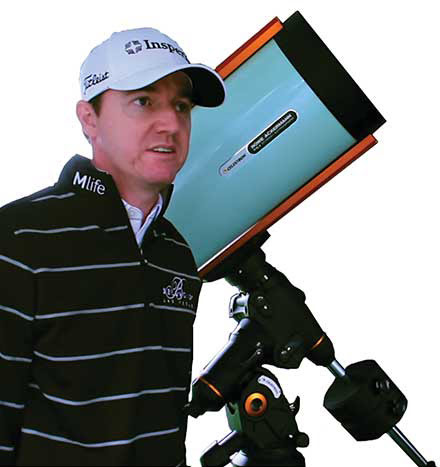It’s a rare event when the worlds of professional sports and optics converge.
But that was the case last month when PGA golf pro Jimmy Walker fended off World No. 1 Jason Day in a thrilling finish to win his first-ever major — the 2016 U.S. PGA Championship.
Not long after Walker hoisted the Wanamaker Trophy, word quickly spread of the elite golfer’s off-course passion: astrophotography.
It turns out that Walker, who happens to have telescope maker Celestron as one of his primary sponsors on tour, spends his spare time taking celestial images. His photographs regularly appear on NASA’s “Astronomy Picture of the Day” website and include the Crescent Nebula, a cosmic bubble, the Pinwheel Galaxy, Bode’s Galaxy and the Soap Bubble Nebula. His work also appears on www.darkskywalker.com.

Astrophoto images courtesy of Jimmy Walker/Celestron.
Walker’s equipment includes a 16-inch reflecting Celestron EdgeHD Pro 1400 telescope, and a CCD camera from Apogee Imaging in California. (Apogee’s parent company, Andor Technology, posted very public Facebook kudos to the golfer after his PGA win.)
Telescope country club
Several years ago, Walker set up his gear at a high-altitude site in New Mexico called New Mexico Skies. In a 2014 profile posted on pga.com, Walker likened the site to a “telescope country club,” home to dozens of telescopes at any given time. Organizations with instruments on the premises read like a “who’s who” among the scientific and university ranks, including NASA, CalTech, Yale University and University of St. Andrews.
The observatory sits some 7,000 ft above sea level and is equipped with rain and cloud sensors that can help identify the perfect conditions for celestial viewing.

Golfer image courtesy of Celestron.
Walker can access his telescope and camera remotely via the internet to conduct imaging sessions. Images are captured in black and white, but a wheel of seven different filters helps add color back to the night sky.
Creating a single image is a lengthy process. Gathering color data can take up to four hours and another three to nine for luminance, according to information from pga.com.
“So once you add it all up, it’s quite a bit of time invested in one image,” Walker said. “The longer you do on an image, the cleaner it looks. It just fills in all the noise gaps and the background where there’s not much signal.”
Walker says the trick to creating memorable images involves practice and knowing how to get the most out of his equipment.
That advice holds true for a stellar round of golf, too.